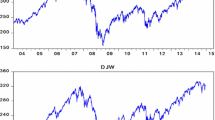Abstract
This study investigates the returns and volatility of bull and bear markets as represented by the Tokyo Stock Price Index (TOPIX). Our results show that bull markets are characterized by high returns and low volatility and that the opposite is true for bear markets. Further, this study uncovers a relationship between the duration of bull and bear markets and the point at which the TOPIX has turned from bull to bear and vice versa. Our results indicate that a bull or bear market has a higher probability of continuing as the duration of market’s current trend lengthens. If a bull or bear market trend persists for more than nine months, its probability of continuing approaches 1. Conversely, the transition from a rising to a declining market, and vice versa, is more likely to occur when the previous trend has persisted for less than nine months.
Similar content being viewed by others
References
Bry, G. & Boschan, C. (1971). Cyclical analysis of time series: Selected procedures and computer programs. National Bureau of Economic Research.
Cuñado J., Gil-Alana L.A., Perezde Gracia F. (2008) Stock market volatility in US bull and bear markets. Journal of Money, Investment and Banking 1: 4–32
Hamilton J. D. (1989) A new approach to the economic analysis of nonstationary time series and business cycle. Econometrica 57(2): 357–384
Hamilton J. D. (1994) Time series analysis. Princeton University Press, Princeton
Harding D., Pagan A. (2002) A comparison of two business cycle dating methods. Journal of Economic Dynamics & Control 27: 1690–1691
Isogai A., Kanoh S., Tokunaga T. (2008) A further extension of duration-dependent models. European Journal of Finance 14(5): 427–449
Lam P. (2004) A Markov-switching model of GNP growth with duration dependence. International Economic Review 45(1): 175–204
Ljung L., Box G. (1978) A measure of lack of fit in time-series models. Biometrika 67: 297–303
Maheu J. M., McCurdy T. H. (2000) Identifying bull and bear markets in stock returns. Journal of Business & Economic Statistics 18(1): 100–112
Shibata, M. (2010). Identifying Bull and Bear markets and statistical analysis of return in Japan (in Japanese). JAFEE Journal, pp. 186–220.
Author information
Authors and Affiliations
Corresponding author
Rights and permissions
About this article
Cite this article
Shibata, M. Identifying Bull and Bear Markets in Japan. Asia-Pac Financ Markets 19, 99–117 (2012). https://doi.org/10.1007/s10690-011-9143-7
Published:
Issue Date:
DOI: https://doi.org/10.1007/s10690-011-9143-7




